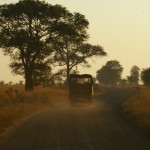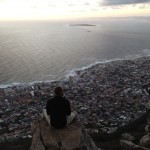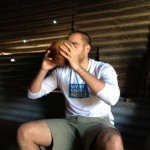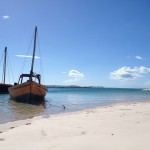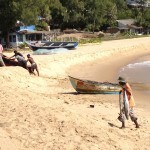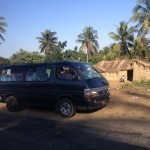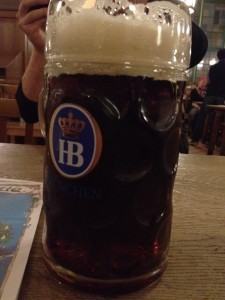Rolf Potts's Blog, page 89
June 23, 2012
Vagabonding Field Report: Autumn in El Chalten, Patagonia
Vagablogging :: Rolf Potts Vagabonding Blog
What ’ s the strangest thing you ’ ve seen lately?
El Chalten is full of the tiniest houses we have ever seen – no bigger than a single room. We puzzled over why this might be for days – perhaps to conserve heating costs or serve as teeny holiday homes – until someone finally explained. They are temporary homes for the seasonal workers. They used to stay in tents, but the campsite became noisy and messy so the government banned them from doing so. As land is expensive and the main holiday season only five months, these little houses are the compromise.
Describe a typical day:
June is the off-season in El Chalten and around 75 per cent of the town shuts its doors and heads elsewhere, making it feel like a ghost town. For the first few days the town was covered in thick grey clouds and intermittent rain. My boyfriend and I stayed huddled inside, learning the ukulele. Then one morning we woke to about two foot of snow and clear skies, the mountains showing themselves for the first time of our visit. It was a breathtaking sight. On the days that followed, we woke early and went hiking in the mountains to glaciers and lakes. We finished each day with an Irish coffee in front of the fire at the town’s whiskey bar – one of the only places that stays open all year round.
Describe an interesting conversation you had with a local:
 Eduardo, the owner of the whiskey bar and El Aldea hotel, became a friend during our time in El Chalten. We loved his passion for whiskey and the mountains of El Chalten. When interviewing him for our blog, If I had a Superpower, we learned his story. Eduardo moved to El Chalten after being in a car crash where he lost his Mum. The tragedy taught him to live each day to its fullest. He finds strength though nature and the mountains, and his spirit was an inspiration to us.
Eduardo, the owner of the whiskey bar and El Aldea hotel, became a friend during our time in El Chalten. We loved his passion for whiskey and the mountains of El Chalten. When interviewing him for our blog, If I had a Superpower, we learned his story. Eduardo moved to El Chalten after being in a car crash where he lost his Mum. The tragedy taught him to live each day to its fullest. He finds strength though nature and the mountains, and his spirit was an inspiration to us.
What do you like about where you are? Dislike?
El Chalten is one of the most beautiful places I have been to. The jagged Fitz Roy range that presides over the town is majestic, and the whole place looked like a wonderland when the snow arrived. The self-guided trails are free and spectacular, although the longer ones were closed due to the snow. Most people go to El Chalten during the summer, but we felt lucky to be there when it was quiet and wintery. That said, we were curious to know what some of the closed businesses would be like – for example the bars and spas. Going there in summer would be a completely different experience, and one we’d like to do one day.
Describe a challenge you faced:
Walking! After the snow, the roads became covered in a thick layer of ice. Getting anywhere was treacherous.
What new lesson did you learn?
 Talking to Eduardo reminded us of the fragility of life, and human strength in overcoming tragedy. We were also repeatedly reminded of the awesomeness of nature.
Talking to Eduardo reminded us of the fragility of life, and human strength in overcoming tragedy. We were also repeatedly reminded of the awesomeness of nature.
Where next?
We left El Chalten a few weeks back and have since been to see the whales in Puerto Madryn, which was incredible. Now we are in Salta where we’ll stay for the next month or so working and volunteering.
You can see more photos and stories from our journey on our blog Bridges and Balloons.
Original article can be found here: Vagabonding Field Report: Autumn in El Chalten, Patagonia
June 22, 2012
Vagabonding Field Report: Making my way from Cape Town to Nairobi (South Africa & Mozambique edition)
Vagablogging :: Rolf Potts Vagabonding Blog
Cost/day: $35/day
What’s the strangest thing you’ve seen lately?
In South Africa, seeing a lion eat an impala, a family of elephants cross the road, two giraffes fight, rhinos hanging out, a leopard chase its prey and a handful of other breathtaking scenes at Kruger National Park was definitely “strange.” It honestly didn’t feel like it could possibly be real.
In Mozambique, the chapas – a shared mini-bus taxi that is typically the only mode of transportation available – are designed to fit 14 people. However, it typically has over 20 people + luggage + household supplies + the occasional live chicken and bag of raw fish. Waiting for and watching everyone squeeze into this vehicle while a guy came up to the window selling a bundle of machetes and an elderly woman came up with a huge barrel of oranges balanced on her head was probably the strangest overall visual of the trip.
Describe a typical day:
South Africa: In Cape Town, I would volunteer with an NGO and then continue to explore the city. In Johannesburg, I spent most of the day hanging out in the Soweto township. I’d walk around the shacks, try the traditional home-made beer and share some amazing food and stories with a group of locals, without utensils of course per their custom.
Mozambique: I’d spend most of the day working remotely on my laptop from a hammock, on a beautiful beach, eating fresh barracuda that I watched being pulled out of the ocean only moments before. I would take the occasional break to swim in the ocean, explore the sand dunes with my new friends or go snorkeling.
Describe an interesting conversation you had with a local:
I met a former Robben Island political prisoner – where Nelson Mandela spent 18 of his 27 years in prison– on the ferry there. He was going back to visit it for the first time since he was a prisoner. He shared stories of the abuse, torture and embarrassment he faced every day at the prison. Even though they had former prisoners conducting the tour, hearing it from a friendly old man that was not part of the museum brought it even more to life.
What do you like about where you are? Dislike?
In South Africa, I liked seeing how much the country had accomplished in overcoming apartheid and how prideful the people were about it. I disliked how even with this accomplishment, its effects were still very prevalent in the country and there is still a long way to go.
In Mozambique, I liked how friendly and laid back the people were, as well as the great weather and the picturesque beaches. Every day felt like you were living in a postcard. I disliked the transportation infrastructure. While I enjoyed and embraced it at first, it eventually got very tiring and time consuming.
Describe a challenge you faced:
It was Sunday and I was heading to a new destination on Monday morning. There was only one bus and it left at 4:00 AM. As I walked up to an ATM for some much needed cash, I shared a quote that I recently read and enjoyed to my friend: An adventure is only an inconvenience rightly considered. An inconvenience is only an adventure wrongly considered (G.K. Chesterton). Seconds after the words left my mouth, the ATM told me to take my card and my money. However, there was no card and no money there. My friend turned to me and said “well that is about as inconvenient as it gets!” I was forced to embrace the quote in real life, instead of just having it simply sound good. It would be impossible to continue throughout Africa without cash or an ATM card, since very few places except credit cards. I canceled my plans and stayed longer. This forced me to slow down and relax. I ended up finding a beautiful deserted island and snorkeled. I also found a place that accepted credit cards and paid for other travelers and they paid me back in cash to solve my cash problem. And in the end, the bank found my card and I was able to get it back. The little inconvenience did in fact turn out to be a nice adventure and everything worked out.
What new lesson did you learn?
I saw extremely poor villages and townships. One consistent theme I saw was that everyone in the community was extremely close. The whole community knew each other intimately. The children called every woman on their street “mom.” If someone in the village was caught stealing, the whole town conducted “community discipline” (they joked that the police is only called by the thief because they need to be saved from the community). Then, I thought about how many people I know from America and Europe citites (including myself) that live in nice neighborhoods and apartment buildings who do not even know their neighbor’s names, much less the people down the street. Even though our average income is probably fifty times higher, it made me wonder which group is actually “richer?”
Where next?
Uganda, Rwanda and Kenya. If interested, you can follow my trip on Facebook, Twitter or my blog.
Original article can be found here: Vagabonding Field Report: Making my way from Cape Town to Nairobi (South Africa & Mozambique edition)
Introducing the Summer Version of the Around the World Airfare Report
Vagablogging :: Rolf Potts Vagabonding Blog
Back in the spring, we at BootsnAll published our first version of the Around the World Airfare Report. The purpose of this research project was to outline the various flight options available to round the world travelers and price out several real itineraries for comparison purposes. We not only recorded the difference in prices, but also customer service, search options, route flexibility, and date flexibility.
As we were putting the finishing touches on the first version of the report, we were already looking forward to the next version, which we just recently published.
Download the free summer version of the Around the World Airfare Report here
Anytime you take on a project like this, you’re bound to learn quite a bit, which will bring about changes the next time you do it. So when we started on this version of the report, we took all feedback we received along with what we learned the first time so we make this version bigger and better.
Like the first time, we searched real RTW routes leaving from three different cities around the world – New York, London, and Sydney. Only this time instead of using the same companies to search from each country, we only used companies located in the respective countries.
We also eliminated searching directly with the airline alliances. There were several reasons for this:
The alliances don’t make RTW tickets a priority. It’s not where they make their money, so they don’t put a lot of resources into these types of tickets. The customer service reps working for the airline alliances simply aren’t as educated as companies who sell these types of tickets themselves or travel agents who specialize in RTW fares.
In the last version, there were a few travel agents who could get us prices on routes by using the alliances, but when working with the alliances directly, they couldn’t offer a quote on that same route, so we made it a point to find travel agents who were well versed in alliance tickets (among other options).
If you’re going to use an alliance (because you have miles with a certain airline or want to build miles), it pays to be very well versed in each one’s terms and conditions, which a travel agent specializing in RTW fares is (moreso than a CSR from an airline alliance).
Alliances are also good for simpler routes that fit well within their rules, and the routes we searched for this version of the project have several out of the way places that we knew would be problematic.
When listening to feedback about the inaugural version of the report that was published in March, we heard concerns about how we searched the one-way flight option using Kayak. Because Kayak uses other sites to book their flights, there was concern that we only used the price on Kayak’s search page rather than clicking through to actually book the ticket and make sure the final price was accurate.
While we did indeed click through in the first version, this time we took it a step further and recorded the original price from Kayak and final price after clicking through. The difference was a miniscule 3.65% (and much of the time the prices were actually lower after clicking through).
So download the free summer version of the RTW Airfare Report, then head on over to the Airfare Report review page to leave your feedback so we can make the third version even better!
Original article can be found here: Introducing the Summer Version of the Around the World Airfare Report
“Outsourced” (2006) — a travel film that gets it right
Vagablogging :: Rolf Potts Vagabonding Blog
When it comes to films about travel, there are more bad movies than good ones. Case in point: “The Way” (2010), which stars Martin Sheen as a doctor who treks the Camino de Santiago (in Spain and France) following the death of his son. There wasn’t a bead of sweat on the characters during the entire film, and I’ve never seen so many trekkers wearing jeans. Every few minutes the characters talk about how no one walks “the way” without being on a personal journey. We got it. The first time.
Sure, there are definitely a handful of spectacular films that fuel my wanderlust–I can’t watch “The Motorcycle Diaries” (2004) without getting the overwhelming urge to hop on a plane to Buenos Aires–but none seem to capture the entire experience of travel.
 Recently, though, on the recommendation of a fellow traveler, I saw an excellent film called “Outsourced” (2006). The main character, a thirty-something manager named Todd, is sent to a small town in India after learning that his entire order fulfillment department has been outsourced. Todd, who works at a company that sells novelty items, is there to teach the new employees how to speak with an American accent and how to deal with American customers. The ensuing US/India culture clash forms the meat of the film.
Recently, though, on the recommendation of a fellow traveler, I saw an excellent film called “Outsourced” (2006). The main character, a thirty-something manager named Todd, is sent to a small town in India after learning that his entire order fulfillment department has been outsourced. Todd, who works at a company that sells novelty items, is there to teach the new employees how to speak with an American accent and how to deal with American customers. The ensuing US/India culture clash forms the meat of the film.
“Outsourced” gets the details right: Todd is rushed by taxi drivers at the Mumbai airport, gets a case of “Delhi Belly” that comes at the worst moment (and without toilet paper), and constantly gets robbed by finger-happy kids. At one point, Todd, having just arrived in the small town, is picked up by his new Indian trainee. They’re stuck in cow-related traffic, and Todd sweats profusely, clearly overcome by the chaos. “You like India?” asks his eager trainee. A moment later, Todd, not realizing that the trainee is his new replacement, explains that what he really does is “sell kitsch to rednecks. Now I have to train some other schmuck to do it.” His trainee replies: “Would you kindly be telling me, what is kitsch, and what is redneck, and what is schmuck?”
There is a romantic story line here, but thankfully, no cliched salvation in a relationship. “Outsourced,” unlike “The Way,” doesn’t hammer you over the head with its message. Instead it takes you on a trip, and in doing so, does a wonderful job of conveying what it’s like to be thrown into an entirely new and different place. (Incidentally, a television adaptation of “Outsourced” was picked up by NBC but cancelled after one season.)
Feel free to share your favorite travel films in the comments!
Original article can be found here: “Outsourced” (2006) — a travel film that gets it right
The joy of research, post #I: Breathing life into the archives
Vagablogging :: Rolf Potts Vagabonding Blog
When writing a novel involving places that actually exist, you need to get the details exactly right or the boat won’t float. And the details aren’t just in the names and locations. It’s the sensory data that pulls the reader in.
I’m currently in the process of writing such a novel. The story takes the main character on a treasure hunt from the dusty archives of Barcelona to the ramshackle seaport of Lisbon and finally to the humid jungles of South America.
Suffice it to say there’s lots of research is involved in such an undertaking. But that’s not to say it’s drudgery. Quite the opposite, actually; the joys will be familiar to many fellow travelers, trip planners, and history buffs.
The details of the various locals matter, big time; I’ve needed to get a sense of the atmosphere of these places to portray them on the page. Take for example one of the books early settings: The Archivo General de Indias in Seville, Spain. The building houses the world’s biggest repository of documents about the Spanish Empire’s expeditions during the Age of Discovery.
I had to be there to breathe in the mustiness that hangs in the air. I had to smell the dust from the ancient, historic parchments flanked by soaring pink marble columns. I had to feel the stale air settle into my lungs as the leather of an old journal’s binding cracks under my fingers as I open it. I had to watch other researchers trawl through yellowing documents, handwritten by real people lost to time. I had to wander the opulent library as historians pore over documents in hope that the faded ink scratches will yield insight.
The majestic old archive in Seville was, as in so many cases, merely the starting point of a larger and greatly enriching journey.
Some call book research “work”. I call it the fun part.
Original article can be found here: The joy of research, post #I: Breathing life into the archives
June 21, 2012
Marco Polo Experiences, or vagabonding off the beaten trail
Vagablogging :: Rolf Potts Vagabonding Blog
During my recent adventures in the Indian Subcontinent, I tried to steer off the beaten tourist trail as much as I could. Thanks to some contacts and friendships I cultivated in other parts of the world – very often a great key for successful connections in other places – I was fortunate enough to venture well far off the beaten path, in places so small that not even a detailed map would carry their names tagged somewhere in microscopic scripts.
Being one of the first foreigners coming to a far flung destination is definitely a great experience, one of those you would write off your book of memories as an anthropological quest, or, as I fondly call, a Marco Polo Experience: a case when, like my Venetian ancestor, your visit and yourself function as a cultural representation of the outside world, an important link between a community and their stereotypical – or plain false- ideas of the outsiders.
After a few forays into the deep backwaters of Bangladesh’s unknownia, I feel like sharing a few tips to maximize your –and your hosts’- experience during one of those rare Marco Polo encounters…
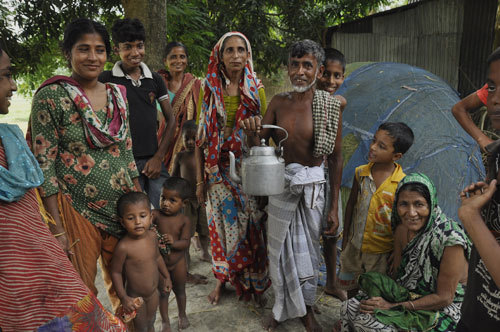
village life in Bangladesh - Picture by Kit Chan, 2012
Be modest in your hospitality
You have come a long way and you have crossed unknown territory to reach here, but this does not mean that you have to exploit the generosity of your hosts. Especially in the South Asian context, where a guest is treated as a gift sent from the Gods, you will be pampered with attention, buried under tons of food, and taken around as a trophy. As much as not indulging in these offers would create a misunderstanding and offend your hosts, it would not be right and not polite to overindulge in their favors. Be modest and considerate when accepting gifts, food or shelter, and possibly bring some gifts to give back. Even a simple print out of a picture of your family would create the most unpredictable awe, and make your hosts extremely happy of having you.
Be aware of the local culture
You do not want to be the example of the ugliness of the Western race, don’t you? Respect their traditions and stick to their rules: in a conservative Muslim society such as the Bengali, for example, shorts are a no no, such as revealing clothes for women, who are also very badly considered when seen smoking. Reserve your mundane pleasures for the outside world or the backpacker’s pad, and try to act decently according to a culture’s rules and regulations. Which of course you have to acknowledge before you go. And pay respect to the village headmaster, if there is one, before entering any of the premises.
Be a worthy ambassador of your own culture
The language barrier should not put you off from trying to communicate with them. Bring along pictures of your family, friends, city, house, sport team or children, and show them around, as they would love it and this would help to foster great communication overcoming any language barrier. Try not to impress too hard tough, and refrain from showing culturally sensitive pictures/objects according to your hosts’ culture.
Be extremely patient
Of course, as we can be ugly, your hosts may be ugly as well. Be very patient, and come armed with an extra dose of chillness before you go. Some people may want to show you around the whole village as a trophy, take you to an unlimited number of houses for sampling an unlimited amount of food or drinks, or just be plain rude according to your own code of cultural rules. Moreover, consider that your personal space will be highly violated: I had dozens of people staring at me as I was brushing teeth, washing clothes, dress up or even just plain eating!! Their curiosity will be endless and as much as you may feel like a lion in a zoo’s cage, this is part of the experience. If you are not ready to find 20 people around your bed staring at you as you wake up from your night’s sleep, you may consider this kind of experience is not suitable for you.
Be ready to act like a rockstar (or a clown)
Because in this situation, you are one. They will feel so enticed by your odd presence – at least for the first couple of days- that any odd request will be asked. If you have a musical instrument with you, be prepared to play it and sing at all hours of the day and night. Be ready to dance and talk as you never did before, answering all of the most personal questions you may be asked. They are just as curious about you as you are about them, and they will show as much as they can. This can lead to some highly entertaining moments, alternated with other frustrating ones when your only desire would be to be able to switch the whole town off with a remote control… once again, keep your cool and be patient. You will miss all of this attention, once you are gone back into the main trail!!
Did you have any similar experience? Do you agree with my suggestions? I would be interested in hearing some other similar stories and share more ideas for untamed independent travel in the backwoods of the world!!
Original article can be found here: Marco Polo Experiences, or vagabonding off the beaten trail
June 20, 2012
Vagabonding Field Report: Beer Festivals in Munich
Vagablogging :: Rolf Potts Vagabonding Blog
Cost/Day- $60
It’s not everyday that I meet a group of 60+ year-old women who are measurably stronger than I am. Then I started visiting Munich’s famed beer halls and this became the status quo. The veteran beer maids of Munich’s Hofbrauhaus and Augustinerkeller, among several other of the city’s gems, boast forearms that would make Mark McGuire blush and routinely carry 8 liters of beer at a time in enormous glass steins. Needless to say, if one of these ladies got my order wrong I wasn’t going to send it back.
A typical day in Munich starts off crisp, with the sun shining down. The Germans aren’t big on sleeping in or lazy Sunday’s so you had better get moving. A walk through the vast and beautiful English Gardens is the best way to get a few lungfuls of fresh air and embrace the Bavarian love of the outdoors. Locals run, stroll and ride their horses through the immaculate and forested grounds. One of the more unique urban features I’ve ever seen exists here. A man-made wave break in the river that flows through the gardens, utilized by surfers to hone their craft hundreds of miles from the ocean. The water certainly requires a wetsuit, but the wave is a clean break and it’s never flat.
After an hour or two of getting exercise, it’s time for the next stage of the Bavarian day, meat and beer. Head over to the permanent covered market, just outside the Marienplatz. If you get there by 11 you can see the Glockenspiel go off for the first time of the day. Take a good look around the market and choose cheap and delicious Bavarian fare from one of the dozens of stalls, then settle down at one of the communal picnic tables and admire the leiderhosen (traditional Bavarian dress) that is still commonly worn on a day-to-day basis by some older residents of Munich.
Undoubtably, the locals will be enjoying a large beer with lunch. If you’ve got what it takes to hang with the guy in leiderhosen then it’s time to make new friends. If you’re more in for taking pictures and saving up for the evening then head over a block and start looking through Munich’s phenomenal crafts stores. If you’ve ever wanted a wooden puppet or cuckoo clock this is the place.
In the evening there’s really only one option if you want an authentic Munich experience and that’s a beer hall. The most famous and popular is the Hofbrauhaus, originally built for Bavarian kings and the site of Hitler’s ill-conceived “Beer Hall Revolt” which landed him in jail. The Hofbrauhaus has been open to the public for a few hundred years now and seats an astonishing seven thousand of your closest friends. Other great options include Augustiner, Paulaner and Spaten.
One of the more interesting exchanges to watch after you’ve been in town for a day or two is the one between a tourist new in town and a waiter in the Hofbrauhaus. It’s a challenge for the tourist to start with because it’s almost impossible to make yourself heard over the din of Germans singing and the polka band. When the tourist finally gets a word in, he typically tries to order a half-liter of beer, a little larger than a standard pint. The waiter then sternly shakes his head to the tourist’s confusion and walks away. The waiter returns a few minutes later with a liter of beer, the only size the Hofbrauhous sells, and inform the patron that there are no “lady sizes” available. The official translation could certainly be viewed as regrettable from a feminist perspective, but the look of the customer’s face as he tries to lift the giant glass makes it well worth it.
Bavaria as a whole is one of the most satisfying and rejuvenating places I have ever been. Everyday is mostly outside with hours of walking and hiking through primordial forests and hilly parks. The food is incredible, although vegetarians beware, meat is what’s on the menu…always. The combination of fresh air, a steady hum of productivity and the old-fashioned wholesome nature of the beer hall are a welcome change from some more modern ng locations in Europe. Despite all the eating and drinking, you’ll walk out of Munich in better shape than when you arrived and feel like you spent a few days in a time machine.
The language barrier is very low in Munich because most of the residents speak English fluently. Public transportation is great and very cheap. The only aspect of life in Munich that could be viewed as challenging could be the brusque nature of many of the locals. Upon first arriving in the city, some may interpret this as rudeness, but it’s simply the efficiency-seeking nature that exists here. When you order in a restaurant, just be ready with what you want and the waiter will be all smiles.
A lesson that was reiterated for me in Munich was to always order what the locals are having, even if you can’t pronounce it. There’s a reason it’s so popular.
Up next… Cabo San Lucas
Original article can be found here: Vagabonding Field Report: Beer Festivals in Munich
Adventure after the adventure ends
Vagablogging :: Rolf Potts Vagabonding Blog
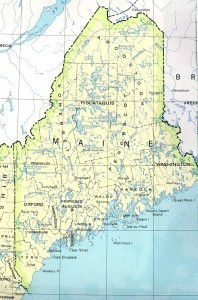 It’s easy to think “travel” and associate it only with the exotic. I imagine exciting exploration, far corners of the earth, and passports filled to the brim. While there are many kinds of travel, we usually don’t associate the same sort of “adventure” with life back at home. This poses a problem, a crisis, even, for those of us who must settle back into post-trip life right where we started.
It’s easy to think “travel” and associate it only with the exotic. I imagine exciting exploration, far corners of the earth, and passports filled to the brim. While there are many kinds of travel, we usually don’t associate the same sort of “adventure” with life back at home. This poses a problem, a crisis, even, for those of us who must settle back into post-trip life right where we started.
One of Rolf’s most helpful pieces of Vagabonding for me relates to reverse culture shock; to the new challenges of “re-entry” into the adventure-less mundane life where we left it. How could settling into Portland Maine ever compare to island hopping in southern Thailand or climbing Nepal’s Annapurna mountains? After reading a Portland travel & lifestyle magazine from cover to cover, I realize: life at “home” doesn’t have to be as awful as I thought.
Vagabonding, as it turns out, is much more of an attitude than a specific distance away from home. Portland Maine, which I once pretentiously considered uninteresting small town USA, is actually a hidden New England gem jam packed with a bustling downtown, incredible food and new people, and is just a stone’s throw from mountains, beaches, and all of the “adventure” that I thought would be absent upon arriving home. What needs changing is my attitude about this place, not the place itself.
 My first adventure will be a weekend jaunt up the Maine coast to places that have been in my backyard for 25 years. I met people on the other side of the world who laughed at the idea that a “Mainer” had never visited such treasured sites as Boothbay Harbor, Acadia National Park and Maine’s beloved Popham beach.
My first adventure will be a weekend jaunt up the Maine coast to places that have been in my backyard for 25 years. I met people on the other side of the world who laughed at the idea that a “Mainer” had never visited such treasured sites as Boothbay Harbor, Acadia National Park and Maine’s beloved Popham beach.
Where do you live? Have you explored your own hometowns in the same way you’ve explored exotic destinations across the world?
Original article can be found here: Adventure after the adventure ends
June 19, 2012
Write a book about your travel adventures, but don’t (literally) shoot yourself to promote it
Vagablogging :: Rolf Potts Vagabonding Blog
The thought of writing a book seems esoteric. Many people I’ve encountered tell me they’re going to write a book someday. (Which I think is a fabulous idea!) The actual process, however, is often unglamorous and tedious. Writing, editing, rewriting, and did I mention rewriting. But writing is only the first step. If you’re following the traditional route; then comes finding an agent, selling the manuscript to a publisher, and marketing it. Your book could deserve a spot on the New York Times short list; but, if no one’s ever heard of it, that’s a problem.
Fifteen years ago I decided that a fitting commemoration to a special friend of mine was to write, then dedicate, a travel book in his honor. Tom was an artist and photographer that loved to connect with people in far-flung places. Yet rather than scurry off to other countries, I spent five years exploring my native country of America trying to understand what people meant when they used the phrase, “Out west.”
West of what?, I wondered…
For me, a girl who grew up in a small colonial New England town; exotic came in the form of branding steers on a Montana ranch, browsing Swedish literature in central Kansas, and attempting to follow a “normal” pace conversation in Spanglish. My passport may only have a half-dozen stamps to date, but I appreciate the depths of my own country. Nearly three years after putting pen to paper, my manuscript will be complete this fall. And one final trip will tie up that journey, leaving free rein for the next.
Personally, the writing process has been as invigorating an adventure as stapling up my horse after he’d been attacked by a bear. For the last three years I’ve networked at an amazing Travel Writing Conference in San Francisco. Spent a weekend in Denver getting direction from National Geographic Photography professionals. And also—twice–attended an intensive month long Creative Writing Workshop in Paris, France. Now a new stage opens up, marketing. This past weekend, a self-promotion strategy came up in conversation–in recent news–that had gone serious wrong.
Read the paragraph below and let me know what you think…
A West Virginia man set out to hitchhike across America and write a photographic memoir about “Kindness in America”. The freelance photographer/traveler took a bus to eastern Montana and began thumbing rides towards the west coast. Not one hundred and fifty miles into his journey he apparently became the victim of a random drive-by shooting along the side of Hwy 2. A kind samaritan stopped to aid him and call 911. The following day an arrest was made but the suspect denied any involvement in the shooting.
Now here’s the twist, several days later while in the hospital, Ray Dolin, confessed that he shot himself to promote his book!
A foray into a story collection such as “The Kindness of Strangers” with a preface by The Dalai Lama could have clued him in that one doesn’t need to self-inflict pain to get attention. So did Dolin get the attention and headlines he wanted? Absolutely! His stunt was written up in a slew of papers as he’s recovering from his bullet wound at a hospital in Miles City, Montana pending charges. Though I’d venture to guess he did himself no favors by blowing a hole in his shoulder.
Have you ever written a book about travel? If so, please share your findings or tips in the comments below…
Or, if you’re toying with the idea of writing a travel book, here are a few links to spring things into action:
Book Passage Travel Writers & Photography Conference, San Fransisco: great for networking
TBEX: Travel Blog Exchange-recently in Colorado, USA-next stop September, Costa Brava, Spain
Matador U: new media school for travelers
Paris American Academy: July summer writing workshop-Paris, France
Gotham Writers’ Workshop: online classes
Angela Ritchie’s Ace Camps: Travel Writing for Modern Audiences
And, read books by your favorite travel authors, and go find a way to meet them!
Original article can be found here: Write a book about your travel adventures, but don’t (literally) shoot yourself to promote it
June 18, 2012
Do you make friends on flights?
Vagablogging :: Rolf Potts Vagabonding Blog

Airplane passenger hoisting a beer. Photo: aroid / Flickr
There was a post on The Economist‘s travel blog titled, Turning seatmates into SeatBuddies. It talks about how airBaltic is following the example of Dutch KLM in allowing passengers to link their social network profiles with the airline website. Then you could pick your seatmate as well as your seat. From the description, it sounds like you get potential candidates who have similar interests to yours.
This excerpt explains the process:
Passengers who want to participate in the scheme will select one of four flight moods before travelling. “Business network” and “easy chat” are for those who want to interact with their seatmate for commercial or social reasons; “work” and “relax” are for those whose approach owes more to Greta Garbo.
I can’t help but think how this feature might be abused. Maybe you could try to get a bigshot as your seatmate, to help secure a job or cut a deal. Or choose an attractive member of the opposite sex. On the other hand, you could use this to avoid passengers you wouldn’t want to sit next to. For example, a screaming baby.
Social networking seems to be creeping into everything these days. Do you think some serendipity is lost? Or would you welcome this level of control over your flight experience?
Would you participate in a service like this? Do you make new friends when you fly? Please share your thoughts in the comments.
Original article can be found here: Do you make friends on flights?
Rolf Potts's Blog
- Rolf Potts's profile
- 323 followers










